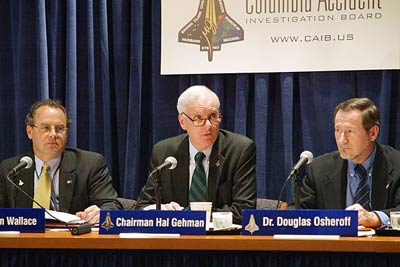The Gehman Boardby Dwayne A. Day
|
| Gehman was always friendly, always easy-going, and yet always able to skillfully direct the board members and staffers toward the goal line. |
At its height, the CAIB essentially consisted of four groups, numbered one through four, with a fifth group dedicated to issues that fell outside the purview of the others. Two of the groups were headed by military general officers, and the other two by civilians. The military groups were primarily staffed by additional military officers selected by their flag or general officers, and they observed their own chain of command. Midway through the investigation one of the civilian scientists remarked that the four groups reflected the cultures that their members came from, and it was true. The military groups tended to be internally hierarchical and strictly agenda-driven. They held morning meetings where they discussed their agendas and then early evening meetings where they discussed what they had done that day. The group dominated by scientists acted more like academics, meaning that they were less organized and did not adhere to a strict agenda—they went where the data took them.
Physicist Richard Feynman once wrote that when he went to see William P. Rogers, the chairman of the commission investigating the Challenger accident, he felt like he was “going to the principal’s office.” If a Nobel Prize winning physicist felt like that, imagine how the rest of the staff felt. Admiral Gehman was the complete opposite. It was easy to talk to him and he was always willing to listen.
Policy and culture
In February 2003, before the policy group was established, one of the youngest staffers used this open access to the Admiral to discuss with Gehman the need to involve social scientists in the investigation. At the time the majority of the staffers were either from the military or from engineering and the hard sciences—aerodynamicists, materials scientists, nuclear and chemical engineers. But this staffer convinced Gehman that the Board needed to look at social issues, such as public policy, organizational theory, human dynamics, and culture. Soon Gehman was actively steering the investigation in that direction. This, combined with pressure from Congress to look at the role of NASA management, policy and budget in the accident, ultimately led to the creation of Group 4, the policy group, headed by Dr. John Logsdon. It later led to bringing in experts on high reliability organizations and organizational culture. Only a month or so before the report was finalized a NASA official was quoted saying that he thought that only one Board member was concerned with the agency’s “culture.” Many of us involved in the investigation groaned when we heard this, seeing it as continued evidence that the agency leadership did not realize that Columbia was more than a technical failure. Those of us involved in the investigation knew that NASA’s dysfunctional safety culture had been at the center of our investigation for months, and that Admiral Gehman had been leading the charge.
| Gehman once remarked that every bureaucracy had two organizational charts—the one that was on paper and the real one. |
Admiral Gehman had a good grasp of the role that culture could play in how an organization operated. During his long career in the Navy he had commanded small units in Vietnam and eventually oversaw a $70-billion budget at the Pentagon (five times NASA’s budget). Nonetheless, it was still surprising to see him recognize the subtleties of human interactions. For instance, several times he commented about NASA’s unwieldy and flawed Flight Readiness Review process before the launch of STS-107. Dozens of people were packed into the room with others connected by speakerphone, and this stifled discussion of critical safety issues. Shuttle managers would ask if there were any dissenting opinions and then conclude that everything was fine because nobody spoke up. What they did not realize, Gehman explained, was that people were intimidated into silence. Shuttle managers were stifling dissent rather than actively seeking and investigating it.
Gehman once remarked that every bureaucracy had two organizational charts—the one that was on paper and the real one. Many things could affect how people really communicate in an organization. On the chart it says that these two people are supposed to talk to each other, he explained, but in reality they don’t. (We in Group 4 learned this lesson ourselves. For over a month I had tried to get the CAIB organization chart altered to reflect the fact that the policy group had over half a dozen people working on it, many with Ph.D.’s. But because of inane reasons I could not get this done—even CAIB had its bureaucratic inertia. Then one day we saw that the chart the Admiral used in public briefings had been updated and we learned that this happened because congressional staffers kept complaining that the policy group had “only one member,” something that was completely untrue. What was on paper and what was really happening were two different things.)
One of the first things Gehman had done when taking over the investigation was read the Challenger accident report. He quickly decided that he would not conduct the Columbia investigation in the same manner and that our final report would be more comprehensive and better written. Gehman also remarked that the one lesson he learned from running the investigation of the bombing of the USS Cole was that he needed a professional writing staff to actually write the report—he could not rely on engineers and military officers to write a report that “has to be understandable by eighth graders and members of Congress.” After the final report was produced, many people commented about how readable it was, and the report even won an award for technical writing.
